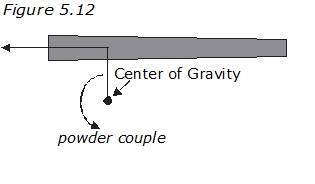What about Recoil?
I decided to look more closely at the movement of the barrels. This was something I had never needed to consider with a bolt-action rifle.
The burning propellant produces a large quantity of gas. The gas exerts a force in three directions – radially, forward and backward. The radial force acts on the barrel walls. I will treat the barrel walls as fixed for this purpose and ignore this force.
The forward force acts against the base of the bullet. The bullet is free to move along the barrel and it does so[1].
An equal but opposite force acts rearwards against the inside of the case head, which in turn exerts a force against the breech face. The rifle moves rearwards in response to this force, constrained by the butt of the rifle held against the shooter’s shoulder. In other words, the rifle is not free simply to recoil rearwards. The point of contact of the butt with the shooter’s shoulder falls below the bore axis and the rifle is free to pivot around this point of contact.
In Ballistics – Theory and Design of Guns and Ammunition[2] the authors describe the process in this way:
Let us now consider the phenomenon known as ‘‘gun jump.’’ The axis of the gun bore, which is where the gas forces are applied, is usually not collinear with the mass center of the recoiling parts. This creates a moment couple often referred to as the ‘‘powder couple,’’ which acts upon firing (Figure 5.12). This couple causes a rotation of the gun that usually results in muzzle rise. This contributes to projectile jump but is by no means the sole cause of it[3].

The analysis above deals with a single barrel system, but is also relevant to a side-by-side rifle. However, in a side-by-side rifle we must also take into account the fact that the pivot point is not directly below the line of force. Instead, it is slightly to the left of the right barrel and to the right of the left barrel.
The consequence of this is that under recoil the barrels tend to rotate away from the centre-line: the right barrel will tend to recoil upwards to the right, while the left barrel recoils upwards and to the left.
The movement will not be the same for both barrels, since the movement of the barrels is constrained by the grip of the shooter on the fore-end. A shooter firing off his right shoulder will grip the fore-end with his left hand. This will limit the ability of the rifle to move to the left when compared with its ability to move to the right. As a result, the left barrel tends to move less than the right and tends to move more in the vertical plane than the horizontal plane. Adding weight to the rifle, such as a scope, will also change its recoil characteristics and so affect the point of impact of the bullets.
We can of course ignore barrel movement that occurs after the bullet leaves the barrel.
Why does all this matter? Because the bullet is moving down the barrel while the barrel is moving. This for me was the Eureka moment. You have to take into account that the barrel is moving while the bullet is travelling down it. Once you do this, Greener’s observations above fall into place.
We need the muzzle of each barrel to be in alignment with the point of aim at the time the bullet leaves the muzzle. And so we must allow for barrel time (the length of time the bullet takes to travel the length of the barrel), and the movement of the barrel under recoil. Therefore, the barrels need to converge in both the vertical and horizontal planes. Or to put it another way, the right barrel must point low and left and the left barrel must point low and right when at rest[4]. Only in this way will the muzzles be aligned with the point of aim at the time the bullet leaves the muzzle.
But how much convergence is needed? In Building Double Rifles on Shotgun Actions, W. Ellis Brown states that a change in convergence of the barrels of 0.004″ will change the spread of the two shots by 1 inch at 50 yards[5]. He also suggests starting with a convergence of 0.080″.
The Nitro Express forum contains this statement on the topic, consistent with W. Ellis Brown:
“As a rough rule of thumb for nitro calibers of .400 up, the barrels are given .003″ of convergence per inch of barrel length in the horizontal plane when they are brazed together. Thus, a .400 with 26″ barrels will start with about .078″ convergence. Likewise, they are given a similar amount of divergence in the vertical plane”
But how do we achieve the desired result? This is the process known as “regulation” and I will turn to this in Part 3 …
[1] I ignore here inertia, air resistance and friction with the barrel walls
[2] Carlucci & Jacobson, 1st Edition, CRC Press 2007 at para 5.3
[3] The text notes that there are other forces at work including stress and pressure waves in the chamber, swelling and elongation due to pressure and a thermal gradient, all of which the text (and I) will ignore.
[4] Shooting the British Double Rifle, 3rd Edition, Graeme Wright at p. 165
[5] Building Double Rifles on Shotgun Actions, W. Ellis Brown at p. 157

